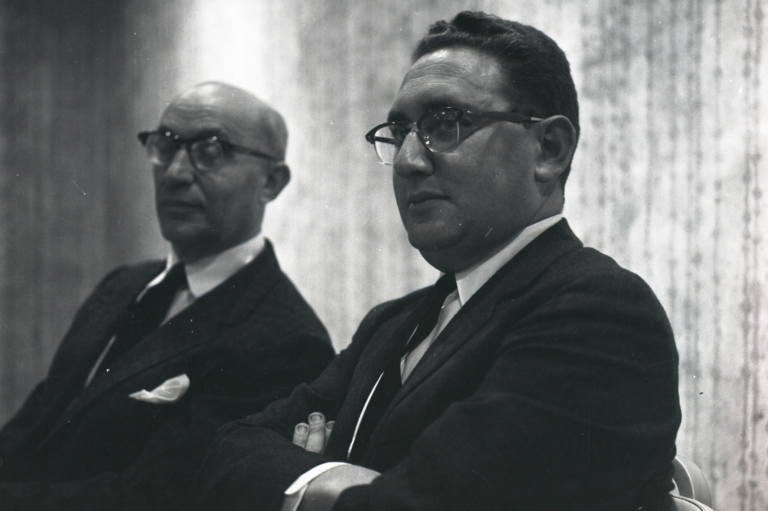All ages of man since the dawn of have borne one or more distinct signatures. The last generation has two well-defined trademarks: The transfer of technology into the hands of the populace leads to freedom from heavy manual labor and the acquisition of more recreational time. Partly as a result of this trend, there is a general increase in individual freedom throughout the world. Human beings have not had sufficient time to adjust to these fundamental changes. It was thus inevitable that there would be conflicts between technology and freedom, with the former being used to restrict the latter. It seems that man’s ingenuity is devoted towards warring against other peoples and against our own fertility.
Coercion and even violence in the name of “family planning” has been imposed with relative ease in at least 35 developing countries to date.
In Salvadorean hospitals, clinics and fieldworkers have been given monthly targets for the number of sterilizations they are to carry out, and women have been sterilized without their knowledge or consent.1
Many Cambodian women have been told that they cannot marry unless they first receive an injection of the abortifacient Depo-Provera.2
Black South African women are given Depo shots by health care workers who tell them that the injections will “help their milk supply,” and Black women cannot apply for jobs unless they present a family planning card showing that they are on some type of birth control. This widespread abuse has certainly not ended with the demise of apartheid. In fact, there are obvious signs that the designers of South Africa’s coercive family planning programs will broaden their scope to target the “Colored” (mixed race) population as well.3
In the 1970s, the Indonesian military was employed in a drive to get as many women as possible fitted (half of whom were directly coerced) with IUDs, and school teachers were told that they would not be paid unless they were on birth control.4
In 1983, Bangladeshi Army troops forcibly rounded up women with three or more children and trucked them to camps for sterilization, and the following year, during widespread flooding, foreign food and medical aid was withheld from destitute women until they agreed to be sterilized.5
As always in such matters, the theory of “graduated coercion” is employed. This means that greater and greater degrees of force are exerted until substantial resistance is encountered. Population controllers Bernard Berelson and Jonathan Lieberson describe this process: “The degree of coercive policy brought into play should be proportional to the degree of seriousness of the present problem and should be introduced only after less coercive means have been exhausted. Thus, overt violence or other potentially injurious coercion is not to be used before noninjurious coercion has been exhausted.”6
There are more than 100 other documented instances of compulsion used in family planning in more than 30 other countries. This prevalence means that these atrocities are not isolated incidents; they are plain evidence of a carefully planned worldwide program designed to cut population growth by whatever means are necessary. Most people think that the international population control agencies are motivated purely by an altruistic concern for the environment. However, the truth is considerably less palatable.
Dr. Charles Ravenholt, former director of the Population Office of the U.S. Agency for International Development, echoed the statements made in the recently declassified National Security Study Memo 200 (NSSM 200) when he said:
“Population control is needed to maintain the normal operation of United States commercial interests around the world. Without our trying to help those countries with their economic and social development, the world could rebel against the strong United States commercial presence. The self interest thing is a compelling element. If the population explosion proceeds unchecked, it will cause such terrible economic conditions abroad that revolutions will ensue. And revolutions are scarcely ever beneficial to the interests of the United States.”7
George Kennan, who devised the theory of Cold War containment of the Soviets, was even more blunt in his assessment:
“We [the United States] have about fifty percent of the world’s wealth, but only six percent of the population. In this situation, we cannot fail to be the object of envy and resentment. Our real task in the coming period is to maintain this position of disparity without positive detriment to our national security… We should cease to talk about vague and unreal objectives such as human rights, the raising of living standards and democratization. The day is not far off when we are going to have to deal in straight power concepts.”
Notice the central point that Kennan is making: The United States must concern itself with the control of developing nations, not their well-being. And what more efficient way to control the power of growing countries than through control of their reproduction?
Case in point: China
“Those women who have already given birth to one child mast befitted with IUDS, couples who already have two children must undergo sterilization of either the husband or the wife, and women pregnant outside the Plan must abort as soon as possible.” — Zhang Boxing, Shanxi Province Communist Party chief.8
The ultimate refinement of antinatalist coercion and violence has been efficiently operating in the People’s Republic of China (PRC) for nearly two decades. Every woman’s fertility is strictly controlled from its onset to its end. The menstrual cycles of female factory workers are charted and displayed on brightly-colored wall boards. Designated workers observe women for morning sickness and other signs of pregnancy. One such “watcher” boasted to an international news team that “It’s very difficult to escape the attention of us family planning workers… No one has ever become pregnant without one of us finding out.”9
In rural areas, the one million members of the “Granny Police” make their ceaseless rounds, ensuring that each woman is using her birth control. Women endure frequent X-rays to insure that they have not removed their IUDs. The rare woman who is pregnant with her second child is deprived of sleep and food and is subjected to days of long interrogations and browbeatings by cadre members working in shifts. This systematic torture continues until the woman agrees to an abortion. In this manner, the Chinese government can claim that its family planning program is “strictly voluntary.”10
Even when a child approaches birth, she is not safe from the rapacious family planners. She is “fair game” during her birth and even after she is born. Michael Weisskopf of The Washington Post describes how workers make sure late-term children never see the light of day:
“In the Inner Mongolian capital of Hohot, however, hospital doctors practice what amounts to infanticide by a different name, according to a Hohot surgeon who would not allow his name to be used for fear of reprisal. After inducing labor, he revealed, doctors routinely smash the baby’s skull with forceps as it emerges from the womb. In some cases, he added, newborns are killed by injecting formaldehyde into the soft spot of the head. He estimated that hundreds of babies die this way in his hospital every year.”
If a woman is unfortunate enough to give birth to twins, she sometimes faces an inhuman “Sophie’s Choice.” She is asked which one she wants, and the other is taken from her and killed.11 Because boy children will one day work for the family, inherit the family name, and care for their parents in their old age, a husband and wife see it as a great disaster if their one allowed child is a girl.
Thus, particularly in rural areas, girl newborns are quickly put to death so that the couple may ‘try again’ for a boy. It is estimated that from 15 to 30 million female newborns have been killed by their parents in China over the last 20 years.12
A burst of defensive essays appeared in the English translations of Chinese magazines following disclosures about the population program. The bottom line of these essays was that “There are no universal and abstract human rights from the Marxist standpoint, all rights emerge historically and are based on economic relations in society.”13
First World: indifferent or worse
When the brutal Chinese policy was finally revealed to the world, many leaders favorable to population control either applauded the program or confirmed by their silence that they approved of it.
Molly Yard, former president of the National Organization for Women (NOW), said that “I consider the Chinese government’s policy among the most intelligent in the world.”14
Paul Ehrlich, founder of the group Zero Population Growth (ZPG), praised China’s program as “remarkably vigorous and effective” and commended it “as a leader in a grand experiment in the management of population and natural resources.”15
Lester R. Brown, president of the Worldwatch Institute, said that “The main difference between China and other densely populated developing countries may be that the Chinese have had the foresight to make projections of their population and resources and the courage to translate their findings into policy.”16
And Garrett Hardin said that “I give the Chinese credit for officially recognizing that they have a problem and for having the nerve to propose the single-child program… They have failed, however, by not making this directive universal throughout the country.”17
From Third World to First
Enforced population control need not be feared if people will be voluntarily responsible in their breeding. 18
As described above, widespread coercion in reproductive matters is relatively easy to implement in nondemocratic societies, where executive power and control of the press is concentrated in the hands of a relatively small elite.
By contrast, in a society where the people have a voice, those people must first acquiesce to the coercion before it can be implemented. In other words, the people must agree to give up their freedoms willingly after being convinced that such is necessary in order to stave off a greater evil.
The “greater evils” in this case are made out to be overpopulation and environmental degradation. Students of history will recognize that no lasting dictatorship can be established without the cooperation of a deceived populace. A mandatory “two-child” policy for the United States has been recommended by scores of influential population controllers since the mid-1960s. In 1969, the organization named Zero Population Growth (ZPG) passed a resolution that held;
(1) Parenthood is not an inherent right but a privilege granted by society which may legitimately limit that privilege. (2) Every American family has a right to two children and no more. 19
Two years later, Edgar Chasteen proposed that Congress pass a law stating “As of January 1, 1975, it shall be unlawful for any American family to give birth to more than two children.” The law would direct that every American be “immunized” against fertility beginning at the age of 10.20
Although these Draconian dreams have not yet reached fruition, there are signs that they may very well become United States government policy in the not-too-distant future. Throughout American history, the poor and disenfranchised population has been targeted for ‘trimming.’ Technology has greatly increased the probability that coercion will be used in matters of reproduction. Space does not permit listing the scores of examples of antinatalist coercion that have been imposed upon the poor in the United States, but one spate of incidents following the introduction of the insertable abortifacient Norplant appears typical.
Immediately after Norplant was introduced to the public, one newspaper editor wrote “As we read these two stories [about Norplant and Black poverty], we asked ourselves: Dare we mention them in the same breath? To do so might be considered deplorably insensitive, perhaps raising the specter of eugenics. But it would be worse to avoid drawing the logical conclusion that foolproof contraception could be invaluable in breaking the cycle of inner city poverty — one of America’s greatest challenges.”21
More than a dozen civil rights leaders pointed out that the editor did not suggest the use of Norplant for the White underclass. Perhaps influenced by the article, several judges ordered women (always poor Blacks) onto the drug because they had been convicted of the abuse of previous children. In one such case, Tulare County (California) Superior Court Judge Howard R. Broadman gave Darlene Johnson a very simple choice: Be sterilized with Norplant or go to jail for two to four years.22 Nor did it take state legislatures long to perceive the dramatic possibilities of using the drug. Kansas H.B. 2089 identified Norplant in an act that would provide assistance to female welfare recipients only if they agreed to be implanted.23
Roots of the violence
In our increasingly freedom-loving world, it would seem that the forceful imposition of the State’s will into the most personal decisions of millions of individuals all over the world would cause shock and anger on a huge scale. However, no such outrage has been in evidence among any of those who claim to adhere to the “pro-choice” philosophy. As a matter of fact, many “pro-choicers,” as described above, enthusiastically support such barbaric measures.
This is because coercion in reproductive matters is only a symptom of a larger problem which runs far deeper than the conflicting ideologies of either side in the abortion debate. The fundamental problem lies in the rejection of any absolute moral standard by the decision-makers of the world, Crimes once thought heinous in the extreme — mass coerced abortion, genocide, systematic widespread rape — are now excused on a variety of grounds, some of which are trivial in the extreme. Our standard for deciding what behaviors are acceptable has gradually shifted from “is it right?” to “can we maintain plausible deniability’?” In other words, as individuals, ethnic groups, or nations, we can do whatever we please as long as we feel the action is in our best interests. As long as the members of societies continue to demand ever-increasing privileges and rights, we will ironically continue to lose individual rights, until no right is safe — not the right to safety, not the right to reproduce, not even the right to live. —PRI—
This article originally appeared in a slightly different form in the Yale Journal of Ethics.
Endnotes
1 The London Observer, 1 April, 1984.
2 “Population Control” Cultural Survival. Fall 1981.
3 Information gathered during author’s August-September 1995 visit to Capetown, Johannesburg, and Soweto, South Africa. ANC population projections of March 1995 show a sudden downturn in the growth rate of the ‘colored’ (mixed race) population, while the growth rates of the Black, Asian, and White populations remain stable.
4 AID’s Role in Indonesian Family Planning United States Agency for International Development, 1979, p. 47. Also see Tempo, 14 July 1984.
5 “A Successful Human Rights Action Against Compulsory Sterilization.” Asia Link (Center for the Progress of Peoples), January 1984.
6 Bernard Berelson and Jonathan Lieberson. “Government Efforts to Influence Fertility: The Ethical Issues,” Population and Development Review, December 1979, page 609.
7 Dr. Charles Ravenholt Quoted in “Population Control of Third World Planned: Sterilization Storm in U.S.” Dublin (Ireland) Evening Press, 12 May, 1979, page 9.
8 Zhang Boxing, directive issues July l0. 1983, quoted in “The Week.” National Review, 27 May, 1988, page 15.
9 WBGH Educational Foundation Documentary Program entitled “China’s Only Child.”
10 A detailed description of China’s family planning program can be found in Steven W. Mosher. Broken Earth: The Rural Chinese (New York: The Free Press, 1983). See in particular Chapter 9, “Birth Control: A Grim Game of Numbers,” pages 224-261.
11 Ibid.
12 World Development Report 1984, page 178.
13 Yi Ding. “Opposing Interference in Other Countries’ Internal Affairs Through Human Rights.” Beijing Review (English language edition), 6-l 2 November, 1989, pages 14 to 16.
14 Molly Yard, 19 March 1989 appearance on the “Oprah Winfrey Show.”
15 Paul R. Ehrlich and Anne H. Ehrlich. “Population, Plenty, and Poverty.” National Geographic Magazine, December 1988, page 922.
16 Lester R. Brown, New York Times, 8 May 1985.
17 “Interview: Garrett Hardin.” Omni magazine, June 1992, pages 56 to 63.
18 Official of the San Jose chapter of Zero Population Growth, in a letter to the San Jose Mercury News. Quoted in Elizabeth Moore. “Feminism and Population Control Not Compatible, Says Germaine Green” NRL News, 23 November 1981, pages 8 and ll.
19 Excerpt quoted in Randy Engel. A Pro-Life Report on Population Growth and the American Future. 1972, page 45.
20 Edgar R. Chasteen. The Case for Compulsory Birth Control. Englewood Cliffs, New Jersey: Prentice-Hall, 1971.
21 Donald Kimelman, “Can Contraception Reduce the Underclass?” Philadelphia Enquirer 12 December 1990.
22 Joe Bigham. “Birth Control Order Stands Until Appeal.” The Oregonian 11 January 1991, page A16.
23 “Chemical Warfare.” Communique [Publication of American Life League, Stafford, Virginia], 1 March 1991, page 1.










